A seminar to mark the closure of the current @UCCLibrary exhibition ‘Claude Pélieu: On All Frequencies’ will take place in the ORB 1.24 this Thursday (September 13, 17-18h) James Horton, the curator will speak about Pelieu and his research. Open to all.
On Claude Pélieu: James Horton interviewed re Pélieu exhibition & Irish Examiner Review.
& here a recent article on the exhibition in The Irish Examiner:
UCC exhibition sheds light on obscure Beat figure
Claude Pélieu fought in Algeria and had a key role in bringing the works of Burroughs and others to the world, writes Marjorie Brennan.

The influence of the Beat Generation has extended far beyond the writers’ core body of work, most of which was produced in the 1950s.
At the centre of the literary turned counter-culture movement were the writers Jack Kerouac, Allen Ginsberg, and William S Burroughs. Helping to propagate their work beyond the US was the relatively unknown French poet and artist Claude Pélieu, who, with his American wife, Mary Beach, completed the first French translations of works by Burroughs, Ginsberg and other Beat writers.
Pélieu is the subject of an exhibition at UCC, curated by James Horton, an English academic based in France.
He has this reputation as a bit of an obscure figure, someone who has slipped out of the pages of history a bit
– says Horton
“I had come across his name in footnotes and bibliographies. It is often quite interesting to see who these translators are because more often than not they are not just translators, they have other poetic and artistic practices going on.”
Horton’s interest was piqued even further when a few years ago, the Bibliotheque National de France acquired a significant archival body of Pélieu’s work and correspondence.
“I found some really fascinating things from letters to drawings and collages going back to 1915. That was the basis of my masters research and those are the archives I h ave drawn on for this exhibition.”
Horton says he was drawn to Pélieu because of his ‘improbable’ life.
He starts off as a young artist in Paris, then begins writing poetry and then quite abruptly at the end of the 1950s, he has a traumatic experience where he has to go fight in the Algerian War. That creates a rupture with France and he moves to the US where he finds a vibrant counter-culture that is very different to the quite conservative cultural system in France
What I really wanted to get across was this singular trajectory and also an overview of how many different things Pélieu does with his life
“In the exhibition, there are drawings, collages, magazines, translated texts, and a range of quite beautiful books. It is a really interesting life that goes along with a very rich multifarious production of images.”
Pélieu moved to the US in 1963 with his second wife Mary Beach, who was a cousin of Sylvia Beach, owner of the legendary Paris bookshop Shakespeare and Co and publisher of Ulysses. Although Pélieu had led a fairly chaotic life, including developing a heroin addiction, Horton says contemporary accounts show his Parisian propriety was also in evidence.

“By the time they moved to the US, the original Beat generation had become a lot more broad and diffuse, moving towards a counter-cultural movement. They lived at the Chelsea Hotel, and quite a few accounts remember them as being quite proper figures. They were always well-dressed and ready to receive company, quite well put together,” says Horton.
A year before he moved to the US, Pélieu visited Ireland, a trip that was so disastrous, he ended up seeking assistance from the French consulate. There is a letter in the exhibition from the French Embassy requesting payment of the cost of his deportation back to France. According to Horton, the visit was prompted by Pélieu’s interest in Celtic poetry and Arthurian legend.
“If you like, it is a sort of European On the Road, with all the farcical and somewhat degenerate elements. He and a friend hitchhiked all the way to Dieppe from Paris, went across to England and via Stonehenge to Wales. Then they arrived in Dublin which Pelieu has nothing good to say about whatsoever. This is a rough translation of what he says in one letter: ‘It is a rotten city, immensely morose… full of drunks, crazies,
alcoholics…’.
“Then they more or less get stranded in Galway for a few weeks and end up going cap in hand to the consulate there. He had terrible toothache the entire time. His first wife says he left with all of his teeth and came back with almost none.”
Pélieu died in 2002, spending his later years in upstate New York. Horton says there is still plenty more to discover when it comes to Pélieu .
“His archive is incredibly dispersed, manuscripts, the art he made, the correspondence. There has been a lot of detective work but that is also what makes him so interesting. It has been a bit of an adventure; fascinating and frustrating in equal measure. I have had some amazing finds… I found a few of his original collages at the bottom of a mouldy cardboard box in Paris. There will always be more out there, he was a prolific letter writer, he was writing dozens of letters a day right up until the end. It is quite thrilling.”
Claude Pélieu: On All Frequencies is at the Boole Library, UCC, until Sept 30
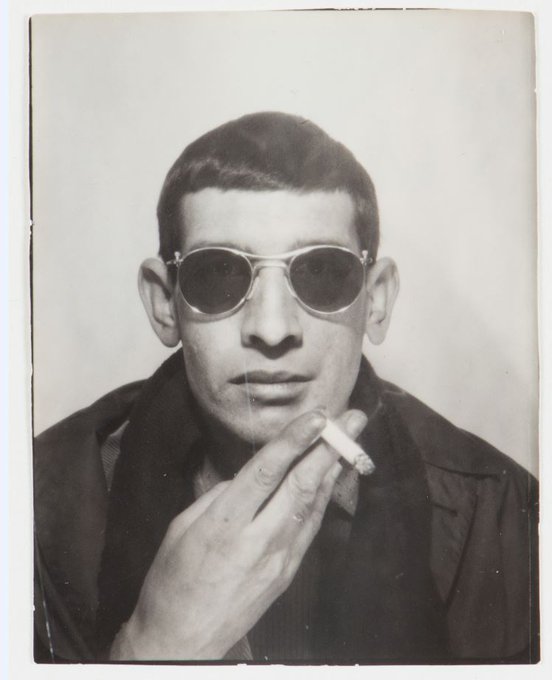
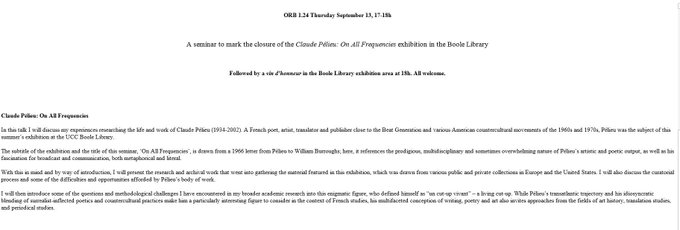

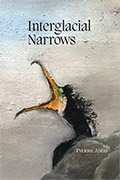 “Interglacial Narrows (Poems 1915-2021)” Contra Mundum Press
“Interglacial Narrows (Poems 1915-2021)” Contra Mundum Press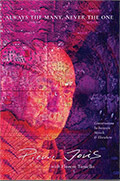 “Always the Many, Never the One: Conversations In-between, with Florent Toniello” Contra Mundum Press
“Always the Many, Never the One: Conversations In-between, with Florent Toniello” Contra Mundum Press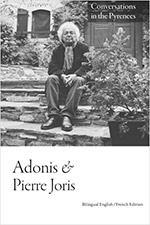 “Conversations in the Pyrenees”
“Conversations in the Pyrenees”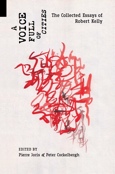 “A Voice Full of Cities: The Collected Essays of Robert Kelly.” Edited by Pierre Joris & Peter Cockelbergh
“A Voice Full of Cities: The Collected Essays of Robert Kelly.” Edited by Pierre Joris & Peter Cockelbergh “An American Suite” (Poems) —Inpatient Press
“An American Suite” (Poems) —Inpatient Press “Arabia (not so) Deserta” : Essays on Maghrebi & Mashreqi Writing & Culture
“Arabia (not so) Deserta” : Essays on Maghrebi & Mashreqi Writing & Culture “Barzakh” (Poems 2000-2012)
“Barzakh” (Poems 2000-2012) “Fox-trails, -tales & -trots”
“Fox-trails, -tales & -trots”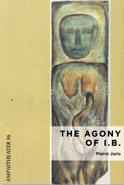 “The Agony of I.B.” — A play. Editions PHI & TNL 2016
“The Agony of I.B.” — A play. Editions PHI & TNL 2016 “The Book of U / Le livre des cormorans”
“The Book of U / Le livre des cormorans”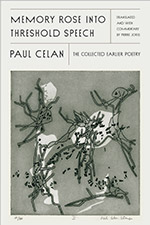 “Memory Rose Into Threshold Speech: The Collected Earlier Poetry of Paul Celan”
“Memory Rose Into Threshold Speech: The Collected Earlier Poetry of Paul Celan”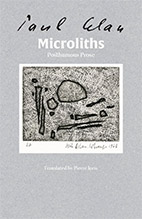 “Paul Celan, Microliths They Are, Little Stones”
“Paul Celan, Microliths They Are, Little Stones”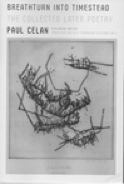 “Paul Celan: Breathturn into Timestead-The Collected Later Poetry.” Translated & with commentary by Pierre Joris. Farrar, Straus & Giroux
“Paul Celan: Breathturn into Timestead-The Collected Later Poetry.” Translated & with commentary by Pierre Joris. Farrar, Straus & Giroux
Thank you so much for sharing this, Pierre!
For quite a while, I have found Pelieu to be an extraordinary poet. Few of his poems can be tracked in Gallimard’s “Anthologie de la poésie française du XX eme siècle tome 2”
I’m afraid his books are all out of print. One would wish not only their re-arrival back in print but that someone would pay back the dues and translate him in American…